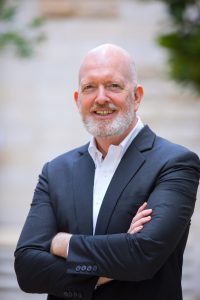Paul Kewene-Hite (ALB 1991) shares his career journey and insights for entrepreneurs.

Being accepted as a bachelor’s degree candidate at HES was like being offered the opportunity to learn how to make keys that unlock the doors of life. Courses at HES taught me to examine and understand how various locks work, which gave me insight into how to fashion keys for those locks.
In the middle of my time at HES I sat in Widener Library and started creating a key for a lock that vexed me: what to do about my entrepreneurial ideas. I decided to create a how-to book with step-by-step instructions that would help anyone examine the locks around their entrepreneurial ideas so that they could start constructing their own keys. I had no idea how to do it, but I started.
When the time came for graduation, I moved west. In the Silicon Valley I was a startup entrepreneur as well as a corporate entrepreneur at both Apple and Japanese tech giant NEC. Later, I moved to Ireland to become CEO of a venture capital backed tech startup.
The next step for me was INSEAD, an international graduate business school in France, where I was first an entrepreneur-in-residence, then executive director of the INSEAD Centre for Entrepreneurship, then an affiliate professor of entrepreneurship. I taught bootcamps using the frameworks from the book I was writing. I led courses on corporate entrepreneurship, business planning, and how to acquire then turnaround a failing business. I taught masterclasses around the world. I taught executive education courses on science & technology entrepreneurship, corporate entrepreneurship, and turn-arounds. Countless hours were invested with students in my office, puzzling through their ideas using the frameworks that I was constructing. I helped build hundreds of startups around the world. Everything that I did at INSEAD fed into the entrepreneurship book that I started writing when I was an HES student.
Months before anyone knew about COVID19, we moved to the countryside of New Zealand. During 2020 I worked with an editor, proofreaders, a page layout professional, and cover designer, then I clicked publish. Thirty-three years in the making, the book that I started writing in Widener Library as an HES student became Survive & Thrive: Entrepreneurship Frameworks That Work. It won awards. You can find it at The Harvard COOP, Barnes & Noble, and Amazon worldwide.
I’m back in Boston now, working as a private consultant helping CEOs, leadership teams, and organizations around the world. I also continue to teach.
On 4 December 2023, my first work of fiction was published. Available at The COOP, Barnes & Noble, and Amazon worldwide, SoWai: A Novel is contemporary business fiction, an allegory about a CEO working to be a force for good by puzzling over locks and fashioning keys to save the world’s fresh water while running his company. Without spoiling too much, a subplot involves someone who reads the book Survive & Thrive, then attends HES as part of the work to unlock the doors of her life. You can too. I did. I still am.
Here are a few tips for entrepreneurs:
- Learn to see everything as entrepreneurship. (Because it is.) Learn to see yourself as an entrepreneur. (Because you are.) Entrepreneurship is ancient and modern. It is how you exist.
- Rather than seeing what needs to be done as assignments and tasks, see the opportunity to learn inside the moment. Do not just do stuff.
- Be strategic: strategy is what you are doing and why. Be tactical: tactics are who, how, when, and where. Unlock the power of which: develop the skill of understanding which strategy and tactics best suit the moment.
- Think critically. Critical thinking is the gathering of facts and data, which inform understanding and insight, which then inform opinion, all of which are used in planning, and then translates into action. Don’t skip understanding and leap straight to opinions…there is too much of that in the world and it makes for weak moments.
- Be a force for good. See yourself as an active participant in making the impossible possible, and the possible probable.



